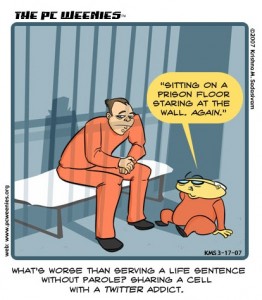Recently, Beth Brenner took the fictional social network “Woof” as warning to those whose social media habits had spiraled out-of-control. Social media discipline is something that nearly everyone in communications struggles with, precisely because there is no one-size-fits-all response.
Should you link your Twitter with Linkedin? How often should you post status updates? Should you separate social contacts from professional ones? And on and on.
There’s the longstanding complaint of influencers updating too frequently about issues that are too trivial, simply because they’re too important to actually lose a significant amount of followers. Yet on the other hand, some of their followers relish in having a voyeuristic insight into the breakfast habits of the famous (a word I use relatively, as it has been redefined by channels like Twitter).
Among those not in the so-called the digerati, Twitter updates are a delicate balancing act. Yes, you want to be a part of the conversation. But will too frequent updates turn-off followers? Or if you don’t update often enough will people forget about you?
Here’s how I’ve started classifying the three main types of Twitterers. I think all provide value, but the hard part is deciding which is right for you (and your brand, because come on, if you’re on social networks, the words “personal brand” have occurred to you at some point).
The Conduit – These are the retweeters, the people who link all their social media accounts. They’re great sources of information and you know that you can always look for their feed to get caught up on all the latest news and trends. The downside? Sometimes they can clog your feed.
The Thinker – These people use social media as a sounding board. They don’t just retweet, they retweet their own take on the issue, often a witty or thought-provoking insight. The downside? In the Twitter echo chamber, it’s hard to know where an idea originated. So even if an idea seems original, your followers might have already heard it. And there is a diminishing return on RTs.
The Writer – These are the stream-of-consciousness tweeters. You get insight into their eating habits, when they sleep, how long they sleep, their dreams, their travel schedule, and when things are going well for them – and when they’re not. These tweets can be hugely beneficial for building an emotional connection with followers, and they often have entertainment value. The downside? The TMI risk.
Of course, most of us are a hybrid of these three. But even so, if you look deeper, I think most people have a guiding Twitter philosophy that often falls into one of these three. What do you think? Do you agree? What other types of Twitterers do you know?
This post was first published by Aarti Shah on March Communications’ blog, PR Nonsense, and may be viewed here.

